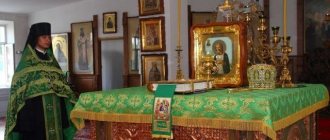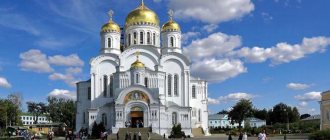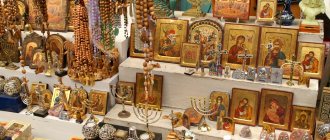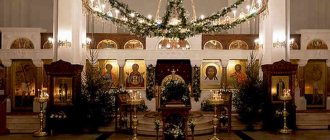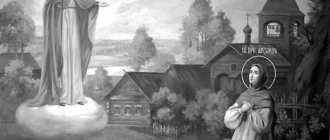At the beginning of the last century, Diveevo was a small village located at the intersection of roads. Pilgrims who were heading to the Sarov monastery spent the night here. In 1758, Agafya Melgunova, a wealthy landowner who was widowed early and took monastic vows, stayed in Diveevo. In a midnight dream, the Mother of God appeared to her and ordered the construction of a monastery on this very spot. Sister Alexandra remained in Diveyevo, erected the first cells, gathered novices and hermits around her, and built the Kazan Cathedral. Before her death, the abbess turned to Father Seraphim - at that time a young deacon - with a request to take care of the monastery. After some time, the priest founded another community nearby, intended exclusively for virgin girls.
Photo: Igor Stomakhin/website
Through the efforts of Father Seraphim, the Churches of the Nativity of Christ and the Nativity of the Virgin Mary appeared next to the Kazan Cathedral. In 1875, the huge Trinity Cathedral, painted with Old Testament scenes, was consecrated in the monastery. Nowadays, restorers have restored the interior: they updated the gold-covered iconostasis, cast new lace fences, and cleaned the walls that go up. The relics of Father Seraphim are kept in the Trinity Cathedral. Next to the shrine you can see things that belonged to the elder: a mantle, a pectoral cross, leather gloves, shoes, a hoe. The relics were found incorrupt and have miraculous power. Many cases of healing were observed among those who venerated the relics with faith in their healing properties.
Desert of the Righteous
Next to the monastery gates, in a small white and green house, there is a museum of Blessed Paraskeva Ivanovna, known as Pasha of Sarov. An amazing woman who lived 120 years, knew how to predict the future and taught how to fight sins. Rumors about her spread throughout Russia. In her room, Pasha received up to a hundred guests a day. In 1903, Tsar Nicholas II and Tsarina Alexandra visited her. Paraskeva Ivanovna received them as ordinary visitors, inviting them to sit on the floor. The blessed one predicted everything that happened later - the death of the dynasty, the defeat of the Church and a sea of blood. She handed the queen a piece of calico with the words: “Take it for your little son’s pants, and when he is born, you will believe everything I said.” A year later, an heir was born into the royal family - Tsarevich Alexei.
Among the original things that belonged to the blessed one, a blue sundress, an icon of John the Baptist and an oil lamp have been preserved. The dolls that she fed, put to bed, and used for fortune-telling are laid out on the bed. A high-quality and clear photograph of Pasha Sarovskaya hangs on the wall. Most likely, it was made by one of the nuns of the monastery. In addition to musical notation, icon painting and lithography, the nuns mastered the techniques of photographic art. The camera on a tripod was brought from St. Petersburg by Abbess Elizaveta Ushakova, an energetic and economic abbess, under whom the monastery reached its greatest prosperity. On the table under glass there are personal belongings, and against the wall there is a harmonium, which Mother Elizabeth loved to play.
In one of the rooms of the museum, the hermitage of Father Seraphim, located in Sarov, is reconstructed. There is no bed in the small cell - the elder slept on a rug near the door. He prayed until late at night, and in the morning he went to obedience. Here is a chair made by the hands of a saint. Seraphim of Sarov seated guests on it, and he himself sat next to it, on a small stump, so as to be slightly lower than the person sitting. This is how the priest expressed his humility before people. The ladder used to move the valve in the furnace was also made by the hands of the elder. He also made a prayer stand in the form of a stool. There is a black spot on the seat. The saint died while praying, and a falling candle set fire to some things, including a stool. In the hermitage hangs a copy of the icon of the Mother of God “Tenderness”. The real icon to which Father Seraphim venerated is located in Moscow, in the Patriarchal chambers. After the Diveyevo Monastery was closed, the holy image was secretly taken to Murom, where it was kept until 1991, then it was transferred to the capital residence of the Patriarch.
The Emperor's Personal Motives
It is well known that the key role in the canonization of Seraphim of Sarov was played by the last Russian emperor, Nicholas II, who personally “put pressure” on Pobedonostsev. Perhaps not the last role in the decisive actions of Nicholas II belonged to his wife, Alexandra Feodorovna, who, as you know, begged Sarovsky to “give Russia an heir after four Grand Duchesses.” After the birth of the Tsarevich, Their Majesties strengthened their faith in the holiness of the elder, and a large portrait with the image of St. Seraphim was even placed in the emperor’s office. Whether personal motives were hidden in the actions of Nicholas II, how much he was carried away by the common love of the royal family for the veneration of miracle workers, whether he sought to overcome the “mediastinum” that separated him from the people is unknown. It is also unclear how significant the influence of the rector of the Spaso-Evfimievsky Monastery, Archimandrite Seraphim (Chichagov), who gave the emperor “an idea about this subject” and presented the “Chronicle of the Seraphim-Diveevsky Monastery” turned out to be. However, it is known that the Elder of Sarov was revered in the imperial family for a long time: according to legend, Alexander I visited him incognito, and the 7-year-old daughter of Alexander II was cured of a serious illness with the help of the mantle of St. Seraphim.
Bear on a birch
Pilgrims from all over Russia come to the Seraphim-Diveevo Convent to venerate the holy relics, stand at the icons, and bathe in healing springs. There are many springs and springs in this region - there is even a guide to the holy springs of the Diveyevo region. But even without a guidebook, everyone knows that the main source is located on the Satis River near the village of Tsyganovka. Several streams merge in one place, forming a small lake. Somewhere here, in a dense forest, Father Seraphim lived in a cell. An elegant chapel built on the shore is dedicated to him.
Along the shore there are elegant log huts for those who want to dive in secret from prying eyes. The water temperature in the Seraphim of Sarov spring, even on the hottest days, does not exceed 4°C. To plunge headlong into holy water three times means to perform a feat in the name of faith and drive away unclean spirits. This is not just bathing, but a whole ritual. A woman, as a sign of purity and submission, should enter the water in a simple shirt, with a scarf on her head. There cannot be frivolous frills, bows, or ribbons on the shirt - as knowledgeable people say, demons can get caught on them. Some pilgrims immerse children's clothes in holy water. They say that God's grace will certainly descend on a child who wears these things.
In Soviet times, a rumor spread around Diveyevo that the local authorities allegedly decided to fill up the spring. A tractor was driven to the water, but the engine immediately stalled. A hunched, gray-haired old man appeared before the tractor driver. He asked not to bury the miraculous reservoir. The worker obeyed and did not do it. Soon a miracle happened - the tractor driver won a Lada car in the lottery. And the party leader who ordered the destruction of the spring was kicked out of work after some time.
Miracles always happen in Diveevo. Either the silhouettes of cathedrals and the outlines of domes will appear in the night sky, then ancient frescoes will appear on the walls of an unrestored church, then a growth in the form of a bear’s muzzle will appear on the birch tree - exactly the same clubfooted bear that Father Seraphim fed from his hand!
Canonization
For the first time, the documented idea of the official canonization of St. Seraphim of Sarov is contained in a letter from Gabriel Vinogradov to the Chief Prosecutor of the Holy Synod, Konstantin Pobedonostsev. This document, dated January 27, 1883, contains a call to “mark the beginning of the reign” of Alexander III with the “discovery of the relics of the pious” Seraphim of Sarov. And only 20 years later, in January 1903, the reverent elder was canonized. Such “indecisiveness” of the Synod is explained by some sources as the saint’s “sympathies” for the Old Believers, which they could not have been unaware of. However, everything seems much more complicated: church power depended, to one degree or another, on state power in the person of the emperor and his representative, the chief prosecutor. And although the latter was never a member of the Synod, he controlled and influenced its activities. The church authorities decided to take a wait-and-see attitude, to “play for time”: of the 94 documented miracles of the Elder of Sarov prepared for his canonization, a small proportion were recognized. It is indeed not easy to separate the actual feat from the fruit of arrogance, the style of the narrator from the actual fact of the reverend’s life. The Synod “did not find the determination to glorify the saint of God,” awaiting the “go-ahead” of the emperor or the providence of God, which ideally should have coincided.
Holy Groove
Ordinary everyday problems, which until recently seemed important, in Diveevo recede into the background and disappear somewhere. Probably, the pastoral rural landscape with front gardens near wooden houses, apple orchards and a quiet river overgrown with reeds has an effect. It is calm, quiet and unfussy here. Local residents ride their bicycles, crossing themselves as they go and greeting their acquaintances with a nod of their heads. From any point in the regional center one can see the domes and bell towers of the monastery cathedrals, covered with clouds of noisy jackdaws and crows. The life of the monastery with its holidays, religious processions, the ringing of bells, nuns, laborers, and novices visible everywhere is dissolved in the Diveyevo atmosphere.
In the evenings, lined up in pairs and holding candles in their hands, the sisters walk around the Holy Canal. Believers believe that the Mother of God appears daily along the tiled path in Diveevo. Anyone can join the procession. In the footsteps of the Queen of Heaven, one must move slowly, repeating the prayer “To the Virgin Mary” many times. Anyone who follows these rules will have all their wishes addressed to children, relatives and loved ones come true.
The ditch appeared in Diveevo not by chance. Once, during the feast of the Presentation, at this very place, Father Seraphim met the Blessed Virgin. Having experienced a feeling of catharsis, the righteous man asked the nuns to dig a deep ring-shaped ditch on the territory of the monastery. The saint dug the first arshin with his own hands. During the years of persecution of the church, they decided to destroy Kanavka - they laid a sewer pipe along the bottom, and piled garbage on top. But the poplars that were once planted along the Kanavka have survived. In the late 1990s, a ditch laid many years ago was restored along these trees. Today the Kanavka looks the same as it did during the old man’s life. A two-meter-high rampart of earth overgrown with grass stretches along a deep and narrow ravine, the walls of which are supported by wooden pegs. The ditch is considered the main shrine of the Seraphim-Diveevo Monastery - it plays the role of a “spiritual wall”. According to many believers, the Antichrist, who is trying to subjugate Russia to his influence, will not be able to get through this barrier.
Letter
During the Sarov celebrations on the occasion of the discovery of the relics of the elder, Nicholas II received the so-called “letter from the past.” The message was written by St. Seraphim and addressed to the “fourth sovereign,” who will arrive in Sarov “to pray especially for me.” What Nikolai read in the letter is unknown - neither the original nor copies have survived. According to the stories of the daughter of Seraphim Chichagov, the Emperor, who accepted the message sealed with soft bread, put it in his breast pocket with a promise to read it later. When Nikolai read the message, he “cryed bitterly” and was inconsolable. Presumably the letter contained a warning about future bloody events and instructions in strengthening faith, “so that in difficult moments of severe trials the Emperor would not lose heart and carry his heavy martyr’s cross to the end.”
Crackers from Father
The sisters of the Seraphim-Diveyevo Monastery wear closed black clothes - a mantle, a hood, and a paraman. Their faces and bodies are open only to eternity. In communication, the nuns are quite friendly, but they are laconic, and they do not have time to talk. Strict discipline reigns in the monastery, everything is scheduled by the hour - early rise, time of prayer and labor. The diet of the nuns can be judged by the lunch that the pilgrims are fed in the refectory. On an ordinary, non-fast day, it consists of a portion of cabbage soup without meat, porridge without butter and tea without sugar. The porridge is prepared differently every day - buckwheat, oatmeal, pearl barley. However, the sisters eat better than the pilgrims: on fasting days they are fed fruits, salads, fish, and dairy products. They prepare a delicious porridge according to the monastery recipe from steamed rice with pumpkin and honey.
Father Seraphim said that the most terrible sin is despondency. In order not to fall into this sin, you need to eat well and not skimp on bread. In the altar of the Transfiguration Cathedral there is a cast iron pot in which the Reverend dried crackers for numerous guests. According to the elder’s behest, crackers are still made in the monastery. Every day, from eight in the morning, crackers consecrated in Father Seraphim’s cauldron are poured out free of charge to pilgrims and tourists. You can only take one ladle per day. Anyone who comes up for crackers a second time will be considered a sinner.
Numerous church shops sell Diveyevo souvenirs - chains and crosses, bells and candlesticks. A brisk trade goes on outside the monastery wall. On the trays are laid out wooden icons and plastic bottles for holy water, bags for soil from Kanavka and cedar rosaries, shirts for bathing in the springs and mugs with the inscription “Diveevo”. The Church does not approve of souvenirs in the form of pebbles with the image of Seraphim of Sarov. Near the official church store you can see a notice with text calling the buyers of pebbles “fans of pagan customs.”
Behind the monastery fence, where there is a monument to Lenin and shopping arcades, the feeling of spiritual uplift weakens a little. The banal bustle of earth again surrounds us from all sides. But somewhere in the depths of my soul there remains a warm feeling of involvement in the miracles that are happening in Diveevo.
Stories about the help of St. Seraphim of Sarov
Starover
The version about the sympathies of St. Seraphim of Sarov for the Old Believers has been discussed since the beginning of the last century to the present day. The falsification of the generally accepted image of the saint as a supporter of the official church was reported, for example, in the “Motovilov papers”, which were presented at the Nomadic Council of 1928. Whether such a Council was actually held is unknown. Its holding was announced by a person with a dubious reputation - Ambrose (Sievers), although a number of researchers (B. Kutuzov, I. Yablokov) recognized the authenticity of the Nomadic Council. The “papers” reported that Prokhor Moshnin (Mashnin) - the name that the monk bore in the world - came from a family of crypto-Old Believers - those who “followed” Nikon only formally, but in everyday life continued to live and pray in Old Russian, almost a thousand years old. Allegedly, this is why the external attributes in Sarovsky’s appearance, which would later be used by supporters of his “Old Believers”, became clear: a cast copper “Old Believer” cross and a lestovka (a special type of rosary). The strict ascetic appearance of the elder was also associated with Donikon Orthodoxy. However, the conversation of the Holy Father with the Old Believers is well known, where he asks them to “leave their nonsense.”
Finding
It is known that on December 17, 1920, the relics of the saint, kept in the Diveyevo Monastery, were opened. In 1926, in connection with the decision to liquidate the monastery, the question arose of what to do with the relics: transfer them to the Penza Union of Atheists or, in the event of religious unrest, to a group of renovationists in Penza. When the final decision to liquidate the monastery was made in 1927, the Bolsheviks decided not to risk it and announced a decree to transport the relics of Seraphim of Sarov and other relics to Moscow “for placement in a museum.” On April 5, 1927, the opening and removal of the relics was carried out. Dressed in a mantle and clothes, the relics were packed into a blue box and, according to eyewitnesses, “dividing into two parties, they sat on several sleighs and drove in different directions, wanting to hide where the relics were being taken.” It is assumed that the relics traveled from Sarov to Arzamas, and from there to the Donskoy Monastery. True, they said that the relics were not brought to Moscow (if they were taken there at all). There is evidence that the holy relics were put on public display in the Passionate Monastery until it was blown up in 1934. At the end of 1990, the relics of the saint were discovered in the storerooms of the Museum of the History of Religion and Atheism in Leningrad. Simultaneously with the news, doubts also appeared: are the relics genuine? The memory of the Sarov monks who replaced the relics in 1920 was still alive in the people's memory. To debunk the myths, a special commission was convened, which confirmed the authenticity of the relics. On August 1, 1991, the holy relics of St. Seraphim of Sarov were returned to the Diveyevo Monastery.
Stories about the help of St. Seraphim of Sarov
Pilgrimage
The huge square of the Seraphim-Diveevsky Monastery
It is often overcrowded with pilgrims coming from all over the country. That is why the monastery fence has several entrances from the street, but knowledgeable people try to go through the Bell Tower. So, after passing under the arch of the bell tower, they get the opportunity to see the cathedral in all its splendor instead of just being on the premises.
Tourists also come to the temple. The Trinity Cathedral in light green colors with its large paved square framed by openwork cast-iron gates is a fascinating and at the same time impressive sight. The Transfiguration Cathedral, wrapped in bright flower beds, attracts with its rounded shapes. The domes on the cathedral shine dazzlingly even in bad weather.
Many who visited the monastery claim
, that male power comes from the Trinity Cathedral, and female power from the Transfiguration Cathedral. Perhaps this is due to the architectural features of the cathedral:
- Troitsky looks straight, slightly angular with steel-gray crowns;
- Preobrazhensky looks slender and soft thanks to its snow-white walls and golden domes.
They walk through the Holy Canal slowly, reciting the prayer to the Most Holy Theotokos 150 times.
. Along the way they stop to pray for the living and the dead. The groove is very long, but you need to start reading prayers from the very first step. Otherwise you won’t be able to make it in time.
There are refectories on the territory of the monastery especially for guests, so that nothing distracts numerous guests and tourists from the true purpose of their visit. For those who plan to stay in Diveevo, several hotels located next to the monastery are ready to provide rooms for a small fee.
